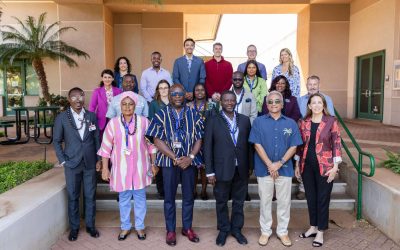One year after the 2017 Freetown mudslide left more than a 1,000 people dead and over 3,000 homeless, Sierra Leone has initiated a bold new partnership to help identify disaster risk reduction (DRR) strategies and expand planning and decision-making capacities throughout the country. Rated as one of the most disaster-prone countries in West Africa, Sierra Leone faces a multitude of risks stemming from flooding, droughts, landslides, health-related issues, windstorms, population density, and a rise in extreme weather events to name only a few.
To further develop effective strategies to anticipate and mitigate these risks, the Government of Sierra Leone kicked off a National Disaster Preparedness Baseline Assessment (NDPBA) in partnership with Pacific Disaster Center (PDC) in Freetown on October 23, 2018. PDC is an applied research center managed by the University of Hawai‘i that promotes risk-informed policies and decisions through risk and vulnerability research, advanced decision support tools, and disaster management best practices. Attended by Sierra Leone’s Disaster Management Department (DMD) of the Office of National Security, the scientific community, academic institutions, and several nongovernmental organizations (NGOs), the NDPBA event marked the beginning of a 12-month assessment to be conducted in collaboration with Sierra Leone’s diverse community.
“We are very optimistic about the new friends and partnership networks we’re creating through the NDPBA in Sierra Leone—the first of its kind for our program in Africa,” said PDC’s Senior Advisor and disaster management expert Tim Manning. He said the NDPBA framework is very flexible and can be adapted to address the unique challenges and hazards present throughout Sierra Leone at the national, subnational, and local level. “Together, we will gain a comprehensive understanding of Sierra Leone’s unique vulnerability profile and build a sustainable platform for interagency collaboration and use of critical risk information into the future,” said Manning.
Adding to Manning’s sentiments, John Vandy Rogers, Sierra Leone’s Director of DMD of the Office of National Security, said Sierra Leone is committed to advancing the DRR goals and objectives of the country and is excited about the partnership opportunity with Pacific Disaster Center. “We are investing in our future through programs like the NDPBA, which will help provide the information and tools necessary to anticipate and mitigate hazard risks of today as well as those of tomorrow,” said Rogers, emphasizing the need for advanced risk management solutions to assist with Sierra Leone’s pronounced health and disaster vulnerabilities. DMD’s Assistant Director Sinneh Mansaray added to Rogers’ remarks, saying, “Sierra Leone is committed to the priorities for action outlined by the Sendai Framework for Disaster Risk Reduction, and this program will position us to better reach those targets.”
During the kick-off event, PDC’s Senior Disaster Management Specialist Todd Bosse facilitated discussions about risks, vulnerabilities, and existing capacities within Sierra Leone. Discussion feedback, as well as other information collected through the NDPBA “will be digitized, made interoperable, and shared back with agency stakeholders for collective decision making into the future,” said Bosse. PDC’s web-based DisasterAWARE decision support software visualizes complex scientific data in a way that is easy to access and understand using a map interface. The software is utilized by numerous NDMOs, NGOs, civil, and military organizations worldwide for decision support.
PDC and the Sierra Leone team will continue to bring together project stakeholders throughout the duration of the project which culminates in a codeveloped five-year Disaster Risk Reduction Action Plan based on assessment findings. The plan will guide disaster management initiatives throughout Sierra Leone and help build national capacity to reduce risks and strengthen resilience for the long-term.






